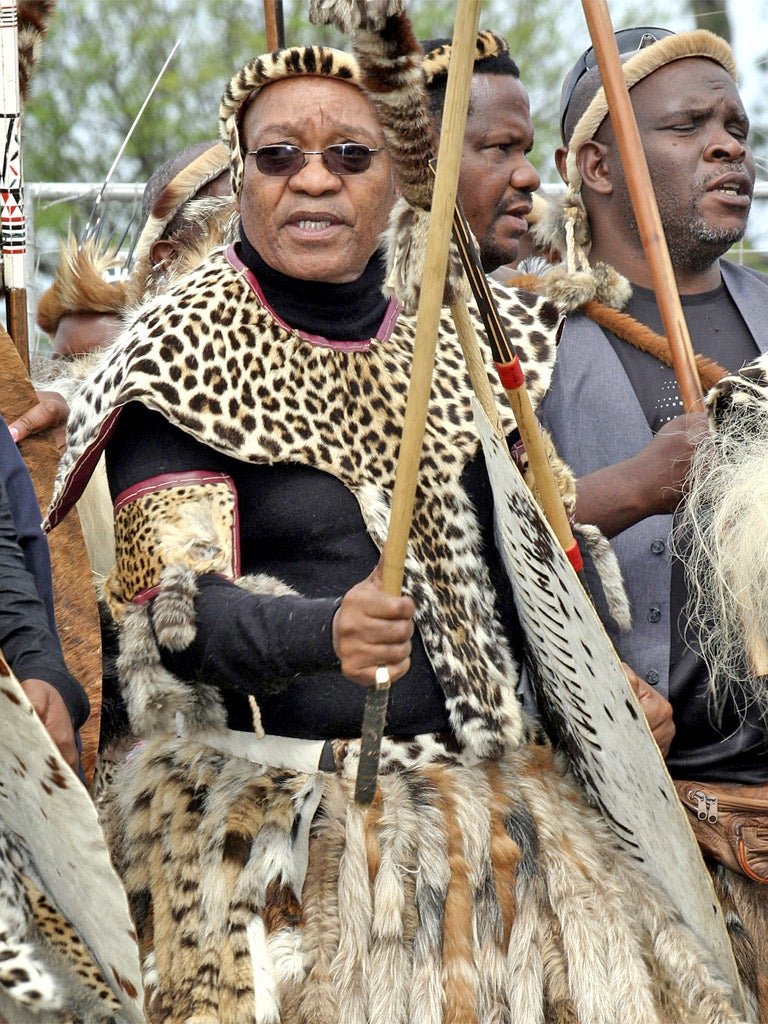Zulus urged to change spots to save leopards
If new, cheap fake fur takes off in South Africa, decline of endangered cats could be halted

A conservation biologist is hoping to convince southern Africa's biggest evangelical church to stop wearing real leopard pelts as ceremonial adornments and instead don synthetic alternatives to try to help conserve the dwindling leopard population.
Tristan Dickerson, a South African who leads the world's biggest study of leopards, is concerned that prominent Zulus, such as South Africa's President Jacob Zuma, are encouraging the tradition by wearing real furs themselves.
The leopard represents power and strength to the Zulus, who are currently enjoying a high profile with the 40th anniversary of King Goodwill Zwelithini's reign. But Mr Dickerson is hoping to convince the 5.6 million followers of the Nazareth Baptist Church – also known as Shembe – that his fake version is just as good as the real thing.
"I have used digital photography and imaging to produce an exact synthetic replica of a leopard-skin stole with all the dots in the right place. It will be machine-washable and will be sold for 500 rand (£40), which makes it far cheaper than the R3,000 Shembe followers spend on the real thing," he said.
On Friday, Mr Dickerson is due to meet representatives of the Nazareth Baptist Church to finalise the terms of a package that the scientist says will also produce jobs in the textile industry of South Africa's KwaZulu--Natal province.
Mkululeko Mthathwe, a spokesman for the Nazareth Baptist Church, said they understood conservation had to be considered as their congregation grew. "We are aware that we cannot keep killing this animal, and yet we cannot stop using leopard skins," he said. "[The synthetic fur] seems to be a good solution. Our church has grown phenomenally and it is true that nature cannot keep up with the demand from our followers."
Mr Dickerson, whose study is in its 10th year at the Phinda Game Reserve in KwaZulu-Natal, said it is impossible to estimate how many leopards remain in Africa. "There was a guesstimate a few years ago of 4,000 in South Africa, but I am not sure how accurate it is," he said. "Another estimate I have seen is 11 leopards per 100,000 square kilometres. But leopards are losing their range due to construction and farmers are shooting them."
Although leopards are listed as endangered and anyone in South Africa owning a pelt should apply for a licence from the local wildlife authority, Mr Dickerson said many do not come forward. Beyond the introduction of fake stoles, the conservationist said the only way to protect the leopard population would be for limited hunting to be allowed. "It sounds contradictory but if we allow farmers to offer leopards for hunts in a regulated way, these animals will become an asset rather than being seen as a pest," he said.
While he may be making progress with the Nazareth Baptist Church, Mr Dickerson's battle is far from won. The scientist was dismayed last Friday to see the Prince of Wales and the Duchess of Cornwall – on an official visit to South Africa – at a Zulu royal pageant featuring dancers wearing leopard skins.
"On the same day as Prince Charles visited a black rhino conservation project, he did not seem to bat an eyelid in the face of all the poached leopard skin he saw at the King's palace," said Mr Dickerson.
Subscribe to Independent Premium to bookmark this article
Want to bookmark your favourite articles and stories to read or reference later? Start your Independent Premium subscription today.

Join our commenting forum
Join thought-provoking conversations, follow other Independent readers and see their replies